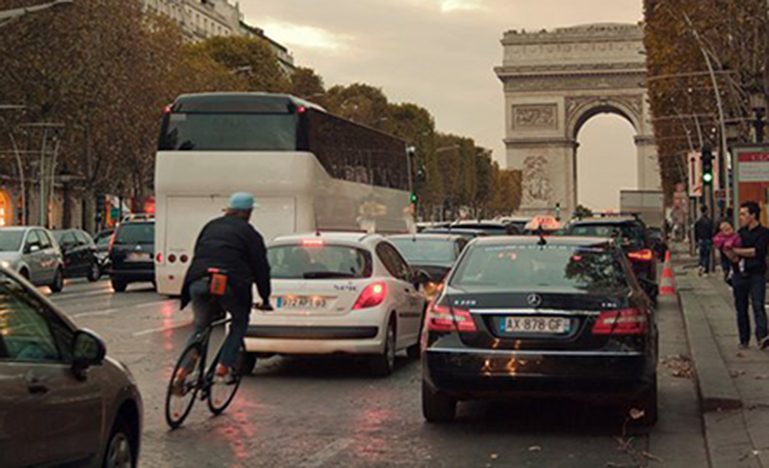Rules of the road: How are we going to regulate autonomous cars?
Canadian regulators pondering the possibility of a truly autonomous car future must grapple with two alternate realities — one where the necessary technology is right around the corner and the other where it’s way down the road. Either way, the question is how safe is safe enough, and at what cost?

Car makers like BMW and Ford are unsurprisingly in the former camp, announcing plans to deliver fully automated vehicles (AV), with Level 5 capabilities – or full automation – within the next five years. Tesla CEO Elon Musk tweeted in January its cars will have that in “3 months maybe, 6 months definitely.” Uber, Google and other technology firms are also investing billions in this space. Self-driving advocates point not only to the potential profits, but also the life-saving and environmental benefits this technology could eventually bring.
But many in the artificial intelligence and engineering community are skeptical about this timeline. They say the technology for AVs to drive in mixed traffic — presumably, without chaos — are still many years away. For all the teeth-gnashing and shirt-rending angst about how AI might eventually kill off the human race, right now it can’t even drive to a suburban mall, let alone handle junctions like Paris’ Etoile, the intersection of Lake Shore Boulevard and Lower Jarvis St in Toronto or pretty much anywhere in Italy.
“When it’s a sunny day and the car is geofenced and there is nothing unusual and the traffic is not too heavy, we are probably there. But unrestricted? That sort of thing is possibly decades away,” said David Danks, a Carnegie Mellon University artificial intelligence ethics expert. AV proponents “massively over-estimate the [current] capabilities. They tend to think we are much closer to [unrestricted automation] than we actually are, and are much more prone to saying: ‘let’s let it loose and see what happens’.”
The race is on
While none of the big players are home-grown Canadian firms, the regulation of and outlook for the automated vehicle (AV) industry is not inconsequential. Canada's automotive industry represents 10 percent of manufacturing GDP, while tech firms like BlackBerry’s automotive software maker QNX are seen as key businesses. “The future of value-added product is in the technology,” said Bob Love at Borden Ladner Gervais, in an email. Love added that Transport Canada is facing “great pressure” to issue some guidelines soon.
“Canada is uniquely positioned to play a leading role in the development of connected and autonomous vehicles,” said Charles Vincent, from Innovation, Science and Economic Development Canada in February, addressing the Standing Senate Committee on Transport and Communications.
“Not only do we have an established automotive manufacturing base, but Canada is also home to the largest IT cluster in North America outside of Silicon Valley, including world-renowned experts in technologies that will be key to the development of connected and autonomous vehicles.”
But what about this chasm between the two visions? Experts directly involved in technology say low speed shuttles are well within reach — and could provide car makers with enough red meat to keep them interested — but the zippy little pods that whisk off customers to desired locations in regular traffic are a ways off.
“I usually punt on this question, say 10-15 years, but ask me again in 5, you might get the same answer,” said University of Waterloo’s Steven Waslander, in an email. Waslander leads the team that is responsible for the “Autonomoose,” one of three self-driving car projects approved in Ontario. “Many more layers of understanding of the physical world are [needed] for sure. Today's successes are impressive compared to earlier work, but as I said … there is a long way to go.”
“Not earlier than 30 years,” said University of Auckland’s Reinhard Klette, an expert in computer vision, in a recent interview for a New Zealand publication. “There are certainly limits to what we can do right now.”
So how will regulators, who have so far lagged behind disruptive 21st century technologies, separate the hype from reality, the benefits to society versus corporate bets? How will Canada in particular, with its “challenging” weather and pressure not to hobble the technology industry, create a driverless framework that is realistic, safe and proportionate to the actual risks? Lastly, given that “a fairly significant infrastructure investment will be required,” according to Vincent, is there a political will for it?
Transport Canada, which is tasked with establishing car safety regulations, says it is studying the issue, including what other jurisdictions are thinking, but it has not “set a firm timeline for regulations.” A framework would give auto makers, tech firms and investors the security and guidance needed to continue investing time and money. It’s unclear what it — and the provincial governments responsible for licensing — would do when auto makers make good on their level 5 promises. Bliss White, a partner at Blakes in Toronto, notes that Canadian laws regulating the operation of motor vehicles are premised on vehicles being under the control of a qualified driver and do not yet contemplate the operation of fully autonomous vehicles.
“While the current Canada Motor Vehicle Safety Standards do not restrict the introduction of automated vehicles in Canada, new federal safety requirements may be needed as vehicles become more automated,” said Transport Canada spokesman Daniel Savoie, in an email.
Ontario, Canada’s most populous province and with the greatest presence in the auto industry, has passed regulations allowing a multi-year pilot project to study the use of Levels 3 (conditional automation), 4 (high automation) and 5 (full) automated vehicles, but otherwise prohibited the operation of such AVs on public roads. Regulators in other Canadian jurisdictions may follow suit in advance of Level 3, 4 or 5 vehicles being introduced, said White.
With auto makers saying the technology is nearly ready, the race is on for some rules. “I would expect to see, at minimum, a policy position issued in 2017,” said Love at BLG, referring to Transport Canada.
Many experts are optimistic when taking the longer view, and say our current state of technology could already support impressive achievements. Driverless cars use a combination of on-board sensors, including AI, cameras, global positioning systems, and telecommunications — essentially, robots on wheels — to move around autonomously.
While unrestricted city driving is far from a done deal, prospects are particularly good for the AV trucking industry, which could be more easily segregated, say some observers. This a large chunk of highway traffic. According to the American Trucking Association, trucks move more than 70 per cent of all goods around the U.S., still the world’s largest economy. Data from these vehicles will be invaluable to the development of more consumer-oriented AVs.
In the next few years, lawmakers — as well as the public — will likely get to see driverless technology in places like rental car parks and airports, some say. It may mean enough profits for car companies to continue down this road. This may partially explain why computing giant Intel just paid $15 billion for Israel’s Mobileye, which makes sensors and cameras for driverless vehicles.
“The technology exists right now for people to build machines to handle many situations, and in many conditions, and often exceeding human performance,” said York University's Michael Jenkin, a member of the Centre for Vision Research. “In five years time, there will be enough automatic vehicles in the environment for people to become familiar with the whole concept, and there will be enough economic returns and public successes to keep everyone happy.”
The Goldilocks dilemma
But how should regulators proceed, particularly as the transition from human-driven cars to AV could be messy? One of the bigger risks to the future of self-driving vehicles is the prospect of a few spectacular accidents, which could result in industry-killing regulations if the technology is unleashed prematurely.
Danks and his colleagues in Pittsburgh think an FDA-style regulatory approval process is the best course of action. While not the speediest route, a “dynamic” framework that mirrors the regulatory and approval process for drugs — one that is flexible and can account for both positive and negative outcomes — could go a long way to ensuring safety. Allow experimentation, verify conclusions and be prepared to change the regulations depending on the outcome, said Danks.
Some Canadian engineers agree. While car/tech companies and universities should be given a good amount of freedom to see what works, regulators need to construct a solid framework for any future commercial deployment, including for taxi-app companies like Uber and Lyft.
“We need a strong governing body with teeth," said Waterloo's Waslander. "An extensive testing regime should be enforced, and a public disclosure of ongoing safety performance in deployed fleets” needs to be considered.
But some in Canada would like to see a looser regulatory environment, arguing that too stringent rules greatly hamper innovation, hurting firms’ chances of advancing technology and delaying the safety benefits that self-driving vehicles could bring. The faster we remove people from the equation, the more lives will be saved from human-error accidents, some observers say.
“AI is moving very quickly and it's expected to be able to handle all sorts of situations,” said Barrie Kirk, director of the Canadian Automated Vehicles Centre Of Excellence. “The promise of AV is a lot fewer deaths and injuries. The key message is don’t over-regulate because it will slow down development,” said CAVCOE's Kirk.
While some observers are very optimistic about so-called “driver assist technology” there is little consensus on the issue of safety of driverless cars— there is simply not enough data, experts point out. For example, Alphabet Inc's Waymo, the poster child of driverless tech, reported that its fleet logged more than 600,000 miles in 2016 on public roads in California. Sounds impressive, but that’s the sum total experience of just nine New York City taxis, which drive an average of 70,000 miles per year, in way more difficult conditions.
“No one has demonstrated even close to the same reliability as human drivers,” said Waslander, pointing to the fact that Google technicians have had to grab the wheel, so-called disengagements, every 5,000 miles. “Humans have accidents every million, and deaths every 100 million. These are not apples to apples comparison, but the order of magnitudes of difference are alarming.”
Another challenge for regulators is the fact that progress is unlikely to follow a smooth, linear path. The transition from driver assist/guardian technology (our currently accepted level 2) to nearly full automation (i.e no steering wheels or pedals), may skip level 3, where the driver takes back control in an emergency. Studies have show that humans are bad at switching their attention, taking too much time to regain “situational awareness.” Car companies like Ford have already said they will likely leap-frog Level 3, and proceed to directly to autonomous mode because of concerns over recovery time.
Apart from the actual mechanics of driving, there is no shortage of challenges that full car automation may cause, with the threat of hacking and privacy infringement topping many experts’ list. It is also unclear how even the best driverless cars — in huge numbers — would perform in mixed traffic, with unpredictable humans on foot or behind the wheel, or what the impact they would have on society.
“Regulators are surely underestimating the near-term turmoil,” said Prof. Ian Bogost at Georgia Institute of Technology, in an email. “This will not be a smooth technical transition.”
So what would happen if autonomous cars are sold with technology that isn’t truly up to speed and regulators take a lax attitude? Some speculate that expense and unreliability of operating such vehicles, including finding the necessary insurance, will likely curb people’s enthusiasm.
“It will start out in the very high end and it will be very expensive," said York's Jenkin. "It may also be very annoying when the car says it can’t handle a situation and has to pull over.”


